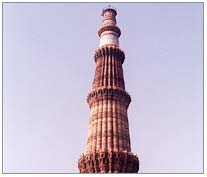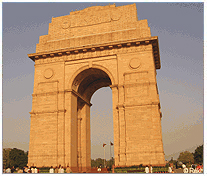RAJASTHAN TOURISM Tour Highlights Delhi Tourism
Delhi Tourism
Qutub Minar
Qutab-ud-din Aibak, the first Muslim ruler of Delhi, commenced the construction of the Qutab Minar in 1200 AD, but could only finish the basement. His successor, Iltutmush, added three more storeys, and in 1368, Firoz Shah Tughlak constructed the fifth and the last storey. The development of architectural styles from Aibak to Tughlak are quite evident in the minar. The relief work and even the materials used for construction differ.
Some believe it was erected as a tower of victory to signify the beginning of the Muslim rule in India. Others say it served as a minaret to the muezzins to call the faithful to prayer. No one can, however, dispute that the tower is not only one of the finest
 monuments in India, but also
in the world.
monuments in India, but also
in the world. The 238 feet Qutab Minar is 47 feet at the base and tapers to nine feet at the apex. The tower is ornamented by bands of inscriptions and by four projecting balconies supported by elaborately decorated brackets.
Even in ruin, the Quwwat Ui Islam (Light of Islam) Mosque in the Qutab complex is one of the most magnificent in the world. Its construction was started by Qutab-ud-din Aibak in 1193 and the mosque was completed in 1197. additions were made to the building by Iltutmush in 1230 and Alla-ud-din Khilji in 1315.
The main mosque comprises of an inner and outer courtyard, of which the inner is surrouded by an exquisite collonade, the pillars of which are made of richly decorated shafts. Most of these shafts are from the 27 Hindu temples which were plundered to construct the mosque. It is, therefore, not surprising that the Muslim mosque has typical Hindu ornamentation.
Close to the mosque is one of Delhi's most curious antiques, the Iron Pillar. Dating back to the 4th century AD, the pillar bears an inscription which stated that it was erected as a flagstaff in honour of the Hindu god, Vishnu, and in the memory of the Gupta king Chandragupta II (375-413). How the pillar moved to its present location remains a mystery. The pillar also highlights ancient India's achievements in metallurgy. The pillar is made of 98 per cent wrought iron and has stood. 1,600 years without rusting or decomposing.
Raj Ghat, Delhi
 A simple open platform inscribed with the Mahatma's last words, 'Hey Ram'
(Oh God) is set in a garden with fountains and a variety of exotic trees.
A simple open platform inscribed with the Mahatma's last words, 'Hey Ram'
(Oh God) is set in a garden with fountains and a variety of exotic trees.
The mortal remains of Mahatma Gandhi were cremated on this spot on the west bank of the river Yamuna on the evening of January 31, 1948.
Jantar Mantar, Delhi
Under patronage from the emperor, he set on himself the task of correcting the existing astronomical tables and updating the almanac with more reliable instruments. Delhi's Jantar Mantar is the first of the five observatories that he built with large masonary instruments.
At first sight, the Jantar Mantar appears like a gallery of modern art. It is, however, an observatory. Sawai Jia Singh II of Jaipur (1699-1743), a keen astronomer and a noble in the Mughal court, was dissatisfied by the errors of brass and metal astronomical instruments.
India Gate, Delhi
 Located on Rajpath, the road which leads to the magnificent Rashtrapati
Bhawan, the gate is 160 feet high with an arch of 138 feet.
Located on Rajpath, the road which leads to the magnificent Rashtrapati
Bhawan, the gate is 160 feet high with an arch of 138 feet.
Built as a memorial to commemorate the 70,000 India soldiers killed in World War I, India Gate was designed by Sir Edwin Lutyens and completed in 1931.
Jama Masjid, Delhi
Work on the Jama Masjid mosque was begun in 1650 by the Mughal Emperor Shah Jahan to complement his palace at the Red Fort. More than 5,000 workers toiled for six years to complete the largest mosque in India. Every Friday, the emperor and his retinue would travel in state from the fort to the mosque to attend the congressional prayers.
A fine example of Mughal architecture, the Jama Masjid has three gateways. The largest and highest on the east was reserve exclusively for the emperor. The main courtyard of the emperor. The main courtyard of the mosque is 408 square feet and paved with red stone. In the centre is a large marble tank in which the devout wash before attending prayers.
Delhi Tourism - Best Price with Free Itinerary Suggestion









